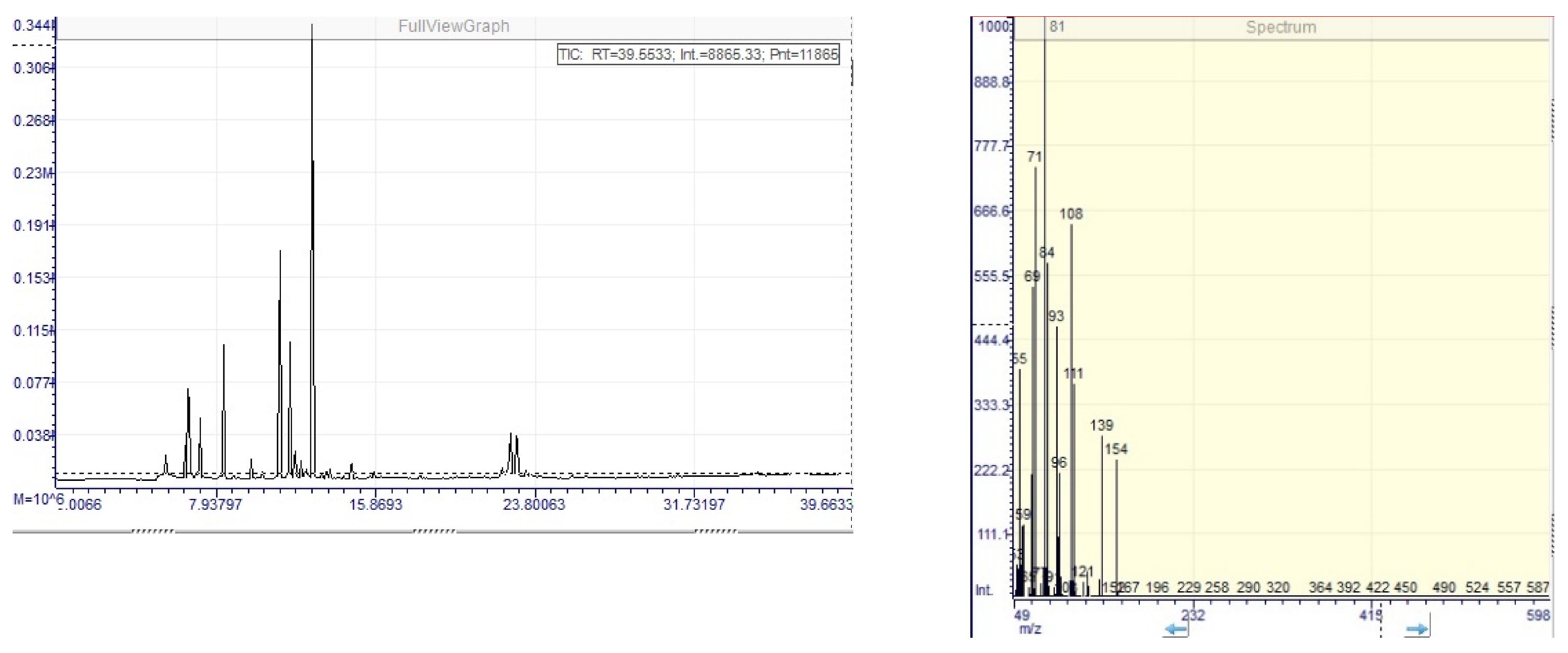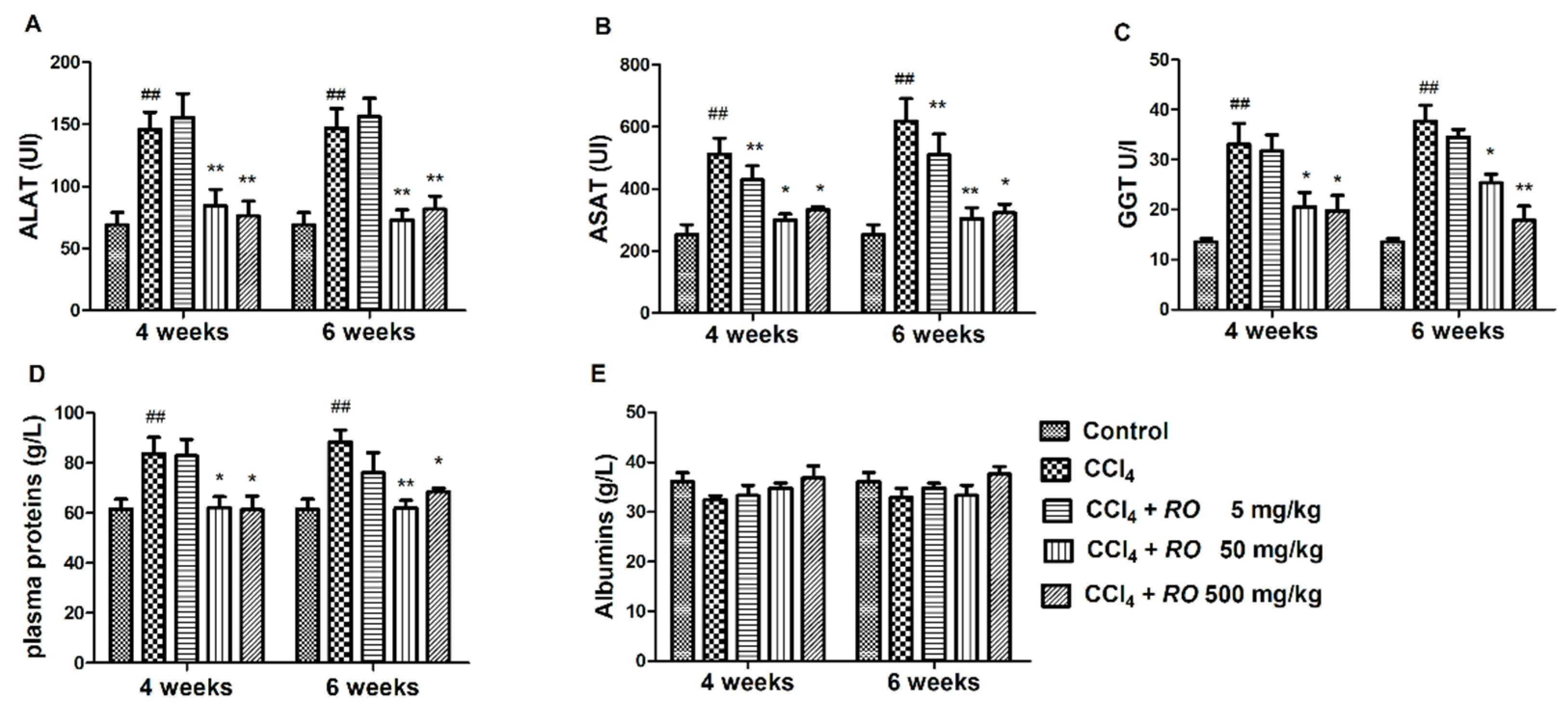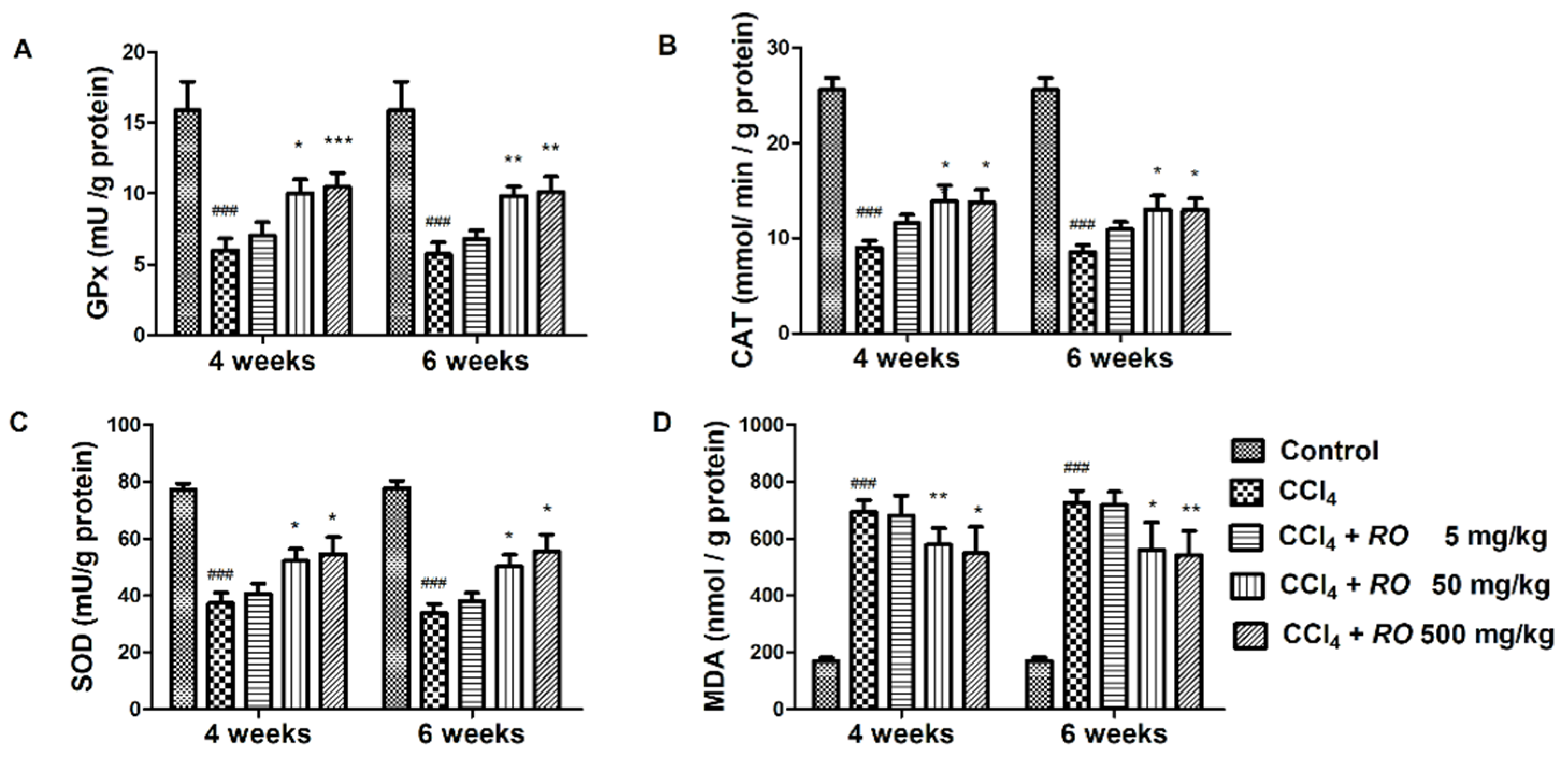Evaluation of Hepatoprotective Activity and Oxidative Stress Reduction of Rosmarinus officinalis L. Shoots Tincture in Rats with Experimentally Induced Hepatotoxicity
Abstract
1. Introduction
2. Results and Discussion
2.1. Phytochemical Analysis of Tincture
2.2. Antioxidant Activity: In Vitro Assays
2.3. Hepatoprotective Activity: Animal Studies
3. Materials and Methods
3.1. Chemicals and Reagents
3.2. Plant Material, Preparation and Characterization of Fresh Young Shoots Tincture
3.3. Quantification of Total Polyphenols, Flavonoids and Phenolic Acids Content
3.4. HPLC/DAD/ESI+ Analysis
3.5. GC–MS Analysis
3.6. Antioxidant Activity Assays
3.6.1. DPPH Radical Scavenging Activity
3.6.2. Ferric-Reducing Antioxidant Power Assay (FRAP)
3.6.3. Superoxide Radical (SO) Scavenging Activity Assay
3.6.4. Animal Studies
3.7. Oxidative Stress Markers and Plasma Biochemistry
3.8. Histology
3.9. Statistical Analysis
4. Conclusions
Author Contributions
Funding
Institutional Review Board Statement
Informed Consent Statement
Data Availability Statement
Acknowledgments
Conflicts of Interest
Sample Availability
References
- Niculae, M.; Hanganu, D.; Oniga, I.; Benedec, D.; Ielciu, I.; Giupana, R.; Sandru, C.D.; Ciocarlan, N.; Spinu, M. Phytochemical profile and antimicrobial potential of extracts obtained from Thymus Marschallianus Willd. Molecules 2019, 24, 3101. [Google Scholar] [CrossRef]
- Benedec, D.; Hanganu, D.; Oniga, I.; Tiperciuc, B.; Olah, N.-K.; Raita, O.; Bischin, C.; Silaghi-Dumitrescu, R.; Vlase, L. Assessment of rosmarinic acid content in six Lamiaceae species extracts and their antioxidant and antimicrobial potential. Pak. J. Pharm. Sci. 2015, 28, 2297–2303. [Google Scholar]
- Mulas, M. Traditional uses of Labiatae in the Mediterranean area. Acta Hortic. 2006, 723, 25–32. [Google Scholar] [CrossRef]
- Ghorbani, A.; Esmaeilizadeh, M. Pharmacological properties of Salvia officinalis and its components. J. Tradit. Complement. Med. 2017, 7, 433–440. [Google Scholar] [CrossRef]
- Shakeri, A.; Sahebkar, A.; Javadi, B. Melissa officinalis L.—A review of its traditional uses, phytochemistry and pharmacology. J. Ethnopharmacol. 2016, 188, 204–228. [Google Scholar] [CrossRef] [PubMed]
- Salehi, B.; Abu-Darwish, M.S.; Tarawneh, A.H.; Cabral, C.; Gadetskaya, A.V.; Salgueiro, L.; Hosseinabadi, T.; Rajabi, S.; Chanda, W.; Sharifi-Rad; et al. Thymus spp. plants—Food applications and phytopharmacy properties. Trends Food Sci. Technol. 2019, 85, 287–306. [Google Scholar] [CrossRef]
- Karadağ, A.E.; Demirci, B.; Çaşkurlu, A.; Demirci, F.; Okur, M.E.; Orak, D.; Sipahi, H.; Başer, K.H.C. In vitro antibacterial, antioxidant, anti-inflammatory and analgesic evaluation of Rosmarinus officinalis L. flower extract fractions. S. Afr. J. Bot. 2019, 125, 214–220. [Google Scholar] [CrossRef]
- Bendif, H.; Boudjeniba, M.; Djamel Miara, M.; Biqiku, L.; Bramucci, M.; Caprioli, G.; Lupidi, G.; Quassinti, L.; Sagratini, G.; Vitali, L.A.; et al. Rosmarinus eriocalyx: An alternative to Rosmarinus officinalis as a source of antioxidant compounds. Food Chem. 2017, 218, 78–88. [Google Scholar] [CrossRef] [PubMed]
- Bakirel, T.; Bakirel, U.; Keleş, O.Ü.; Ülgen, S.G.; Yardibi, H. In Vivo assessment of antidiabetic and antioxidant activities of rosemary (Rosmarinus officinalis) in alloxan-diabetic rabbits. J. Ethnopharmacol. 2008, 116, 64–73. [Google Scholar] [CrossRef]
- Borges, R.S.; Sánchez Ortiz, B.L.; Matias Pereira, A.C.; Keita, H.; Tavares Carvalho, J.C. Rosmarinus officinalis essential oil: A review of its phytochemistry, anti-inflammatory activity, and mechanisms of action involved. J. Ethnopharmacol. 2019, 229, 29–45. [Google Scholar] [CrossRef] [PubMed]
- Farghali, H.; Canová, N.K.; Zakhari, S. Hepatoprotective properties of extensively studied medicinal plant active constituents: Possible common mechanisms. Pharm. Biol. 2015, 53, 781–791. [Google Scholar] [CrossRef] [PubMed]
- Madrigal-Santillán, E.; Madrigal-Bujaidar, E.; Álvarez-González, I.; Sumaya-Martínez, M.T.; Gutiérrez-Salinas, J.; Bautista, M.; Morales-González, Á.; García-Luna, Y.; González-Rubio, M.; Aguilar-Faisal, J.L.; et al. Review of natural products with hepatoprotective effects. World J. Gastroenterol. 2014, 20, 14787–14804. [Google Scholar] [CrossRef] [PubMed]
- Zhang, A.; Sun, H.; Wang, X. Recent advances in natural products from plants for treatment of liver diseases. Eur. J. Med. Chem. 2013, 63, 570–577. [Google Scholar] [CrossRef]
- Rašković, A.; Milanović, I.; Pavlović, N.; Ćebović, T.; Vukmirović, S.; Mikov, M. Antioxidant activity of rosemary (Rosmarinus officinalis L.) essential oil and its hepatoprotective potential. BMC Complement. Altern. Med. 2014, 14, 1–9. [Google Scholar] [CrossRef]
- Amin, A.T.; Hamza, A. Hepatoprotective effects of Hibiscus, Rosmarinus and Salvia on azathioprine-induced toxicity in rats. Life Sci. 2005, 77, 266–278. [Google Scholar] [CrossRef]
- Lucarini, R.; Bernardes, W.A.; Tozatti, M.G.; da Silva Filho, A.A.; Silva, M.L.A.; Momo, C.; Crotti, A.E.M.; Martins, C.H.G.; Cunha, W. Hepatoprotective effect of Rosmarinus officinalis and rosmarinic acid on acetaminophen-induced liver damage. Emir. J. Food Agric. 2014, 26, 878–884. [Google Scholar] [CrossRef]
- Fadlalla, E.A.S.; Galal, S.M. Hepatoprotective and reno-protective effects of artichoke leaf extract and rosemary extract against Paracetamol induced toxicity in Albino Rats. J. Pharm Res. Int. 2020, 32, 67–81. [Google Scholar] [CrossRef]
- Hegazy, A.M.; Abdel-Azeem, A.S.; Zeidan, H.M.; Ibrahim, K.S.; El-Sayed, E.M. Hypolipidemic and hepatoprotective activities of rosemary and thyme in gentamicin-treated rats. Hum. Exp. Toxicol. 2018, 37, 420–430. [Google Scholar] [CrossRef]
- Bahri, S.; Ben Ali, R.; Abdennabi, R.; Ben Said, D.; Mlika, M.; Ben Fradj, M.K.; El May, M.V.; Jameleddine, S.B.K. Comparison of the protective effect of Salvia officinalis and Rosmarinus officinalis infusions against hepatic damage induced by hypotermic-ischemia in Wistar rats. Nutr. Cancer 2020, 72, 283–292. [Google Scholar] [CrossRef]
- Martínez-Rodríguez, J.L.; Gutiérrez-Hernández, R.; Reyes-Estrada, C.A.; Granados-López, A.J.; Pérez-Veyna, O.; Arcos-Ortega, T.; López, J.A. Hepatoprotective, antihyperlipidemic and radical scavenging activity of hawthorn (Crataegus oxyacantha) and rosemary (Rosmarinus officinalis) on alcoholic liver disease. Altern. Ther. Health Med. 2019, 25, 54–63. [Google Scholar]
- El-Hadary, A.E.; Elsanhoty, R.M.; Ramadan, M.F. In vivo protective effect of Rosmarinus officinalis oil against carbon tetrachloride (CCl4) -induced hepatotoxicity in rats. PharmaNutrition 2019, 9, 1–7. [Google Scholar] [CrossRef]
- Selmi, S.; Rtibi, K.; Grami, D.; Sebai, H.; Marzouki, L. Rosemary (Rosmarinus officinalis) essential oil components exhibit anti-hyperglycemic, anti-hyperlipidemic and antioxidant effects in experimental diabetes. Pathophysiology 2017, 24, 297–303. [Google Scholar] [CrossRef] [PubMed]
- Ngo, Y.L.; Lau, C.H.; Chua, L.S. Review on rosmarinic acid extraction, fractionation and its anti-diabetic potential. Food Chem. Toxicol. 2018, 121, 687–700. [Google Scholar] [CrossRef]
- Elufioye, T.O.; Habtemariam, S. Hepatoprotective effects of rosmarinic acid: Insight into its mechanisms of action. Biomed. Pharm. 2019, 112, 1–11. [Google Scholar] [CrossRef]
- Maldini, M.; Montoro, P.; Addis, R.; Toniolo, C.; Petretto, G.L.; Foddai, M.; Nicoletti, M.; Pintore, G. A new approach to discriminate Rosmarinus officinalis L. plants with antioxidant activity, based on HPTLC fingerprint and targeted phenolic analysis combined with PCA. Ind. Crops Prod. 2016, 94, 665–672. [Google Scholar] [CrossRef]
- Jemia, M.B.; Tundis, R.; Maggio, A.; Rosselli, S.; Senatore, F.; Menichini, F.; Bruno, M.; Kchouk, M.E.; Loizzo, M.R. NMR-based quantification of rosmarinic and carnosic acids, GC-MS profile and bioactivity relevant to neurodegenerative disorders of Rosmarinus officinalis L. extracts. J. Funct. Foods 2013, 5, 1873–1882. [Google Scholar] [CrossRef]
- Moore, J.; Yousef, M.; Tsiani, E. Anticancer effects of rosemary (Rosmarinus officinalis L.) extract and rosemary extract polyphenols. Nutrients 2016, 8, 731. [Google Scholar] [CrossRef]
- Bai, N.; He, K.; Roller, M.; Lai, C.S.; Shao, X.; Pan, M.H.; Ho, C.T. Flavonoids and phenolic compounds from Rosmarinus officinalis. J. Agric. Food Chem. 2010, 58, 5363–5367. [Google Scholar] [CrossRef]
- Risaliti, L.; Kehagia, A.; Daoultzi, E.; Lazari, D.; Bergonzi, M.C.; Vergkizi-Nikolakaki, S.; Hadjipavlou-Litina, D.; Bilia, A.R. Liposomes loaded with Salvia triloba and Rosmarinus officinalis essential oils: In vitro assessment of antioxidant, antiinflammatory and antibacterial activities. J. Drug Deliv. Sci. Technol. 2019, 51, 493–498. [Google Scholar] [CrossRef]
- Ainane, A.; Khammour, F.; Charaf, S.; Elabboubi, M.; Elkouali, M.; Talbi, M.; Benhima, R.; Cherroud, S.; Ainane, T. Chemical composition and insecticidal activity of five essential oils: Cedrus atlantica, Citrus limonum, Rosmarinus officinalis, Syzygium aromaticum and Eucalyptus globules. Mater. Today Proc. 2019, 13, 474–485. [Google Scholar] [CrossRef]
- Ramadan, M.F.; Khider, M.; Abulreesh, H.H.; Assiri, A.M.A.; Elsanhoty, R.M.; Assaeedi, A.; Elbanna, K. Cold pressed rosemary (Rosmarinus officinalis) oil. Cold Pressed Oils 2020, 683–694. [Google Scholar] [CrossRef]
- Borrás-Linares, I.; Stojanović, Z.; Quirantes-Piné, R.; Arráez-Román, D.; Švarc-Gajić, J.; Fernández-Gutiérrez, A.; Segura-Carretero, A. Rosmarinus officinalis leaves as a natural source of bioactive compounds. Int. J. Mol. Sci. 2014, 15, 20585–20606. [Google Scholar] [CrossRef] [PubMed]
- Okamura, N.; Haraguchi, H.; Hashimoto, K.; Yagi, A. Flavonoids in Rosmarinus officinalis leaves. Phytochemistry 1994, 37, 1463–1466. [Google Scholar] [CrossRef]
- Zoral, M.A.; Futami, K.; Endo, M.; Maita, M.; Katagiri, T. Anthelmintic activity of Rosmarinus officinalis against Dactylogyrus minutus (Monogenea) infections in Cyprinus carpio. Vet. Parasitol. 2017, 247, 1–6. [Google Scholar] [CrossRef]
- Ali, A.; Chua, B.L.; Chow, Y.H. An insight into the extraction and fractionation technologies of the essential oils and bioactive compounds in Rosmarinus officinalis L.: Past, present and future. Trends Anal. Chem. 2019, 118, 338–351. [Google Scholar] [CrossRef]
- Csepregi, K.; Neugart, S.; Schreiner, M.; Hideg, É. Comparative evaluation of total antioxidant capacities of plant polyphenols. Molecules 2016, 21, 208. [Google Scholar] [CrossRef]
- Mishra, K.; Ojha, H.; Chaudhury, N.K. Estimation of antiradical properties of antioxidants using DPPH- assay: A critical review and results. Food Chem. 2012, 130, 1036–1043. [Google Scholar] [CrossRef]
- Szollosi, R.; Szollosi Varga, I. Total antioxidant power in some species of Labiatae (Adaptation of FRAP method). Acta Biol. Szeged 2002, 46, 125–127. [Google Scholar]
- Olah, N.K.; Osser, G.; Câmpean, R.F.; Furtuna, F.R.; Benedec, D.; Filip, L.; Raita, O.; Hanganu, D. The study of polyphenolic compounds profile of some Rosmarinus officinalis L. extracts. Pak. J. Pharm Sci. 2016, 29, 2355–2361. [Google Scholar] [PubMed]
- Gîrd, C.E.; Nencu, I.; Popescu, M.L.; Costea, T.; Duţu, L.E.; Balaci, T.D.; Olaru, O.T. Chemical, antioxidant and toxicity evaluation of rosemary leaves and its dry extract. Farmacia 2017, 65, 978–983. [Google Scholar]
- Jacobo-Velázquez, D.A.; Cisneros-Zevallos, L. Correlations of antioxidant activity against phenolic content revisited: A new approach in data analysis for food and medicinal plants. J. Food Sci. 2009, 74, 107–113. [Google Scholar] [CrossRef]
- Azzahra, L.F.; Fouzia, H.; Mohammed, L.; Noureddine, B. Antioxidant response of Camellia sinensis and Rosmarinus officinalis aqueous extracts toward H2O2 stressed mice. J. Appl. Pharm Sci. 2012, 2, 70–76. [Google Scholar] [CrossRef][Green Version]
- El-hawary, S.S.; Ezzat, S.M.; Elshibani, F. Gas chromatography-mass spectrometry analysis, hepatoprotective and antioxidant activities of the essential oils of four Libyan herbs. J. Med. Plants Res. 2013, 7, 1746–1753. [Google Scholar]
- Boll, M.; Weber, L.W.D.; Becker, E.; Stampfl, A. Mechanism of carbon tetrachloride-induced hepatotoxicity. Hepatocellular damage by reactive carbon tetrachloride metabolites. Z. Nat. Sect. C J. Biosci. 2001, 56, 649–659. [Google Scholar] [CrossRef]
- Stan, M.S.; Voicu, S.N.; Caruntu, S.; Nica, I.C.; Olah, N.K.; Burtescu, R.; Balta, C.; Rosu, M.; Herman, H.; Hermenean, A.; et al. Antioxidant and anti-inflammatory properties of a Thuja occidentalis mother tincture for the treatment of ulcerative colitis. Antioxidants 2019, 8, 416. [Google Scholar] [CrossRef]
- Ielciu, I.; Frederich, M.; Hanganu, D.; Angenot, L.; Olah, N.K.; Ledoux, A.; Crisan, G.; Paltinean, R. Flavonoid analysis and antioxidant activities of the Bryonia alba L. aerial parts. Antioxidants 2019, 8, 108. [Google Scholar] [CrossRef]
- Sevastre-Berghian, A.C.; Ielciu, I.; Mitre, A.O.; Filip, G.A.; Oniga, I.; Vlase, L.; Benedec, D.; Gheldiu, A.M.; Toma, V.A.; Mihart, B.; et al. Targeting oxidative stress reduction and inhibition of HDAC1, MECP2, and NF-kB pathways in rats with experimentally induced hyperglycemia by administration of Thymus marshallianus Willd. extracts. Front. Pharmacol. 2020, 11, 1–18. [Google Scholar] [CrossRef] [PubMed]
- Badalica-Petrescu, M.; Dragan, S.; Ranga, F.; Fetea, F.; Socaciu, C. Comparative HPLC-DAD-ESI(+)MS fingerprint and quantification of phenolic and flavonoid composition of aqueous leaf extracts of Cornus mas and Crataegus monogyna, in relation to their cardiotonic potential. Not. Bot. Horti Agrobot. 2014, 42, 9–18. [Google Scholar] [CrossRef]
- Hanganu, D.; Benedec, D.; Olah, N.K.; Ranga, F.; Mirel, S.; Tiperciuc, B.; Oniga, I. Research on enzyme inhibition potential and phenolic compounds from Origanum vulgare ssp. vulgare. Farmacia 2020, 68, 1075–1080. [Google Scholar] [CrossRef]
- Mot, A.C.; Damian, G.; Sarbu, C.; Silaghi-Dumitrescu, R. Redox reactivity in propolis: Direct detection of free radicals in basic medium and interaction with hemoglobin. Redox Rep. 2009, 14, 267–274. [Google Scholar] [CrossRef] [PubMed]
- Benzie, I.; Strain, J. The ferric reducing ability of plasma (FRAP) as a measure of “antioxidant power”: The FRAP assay. Anal. Biochem. 1996, 239, 70–76. [Google Scholar] [CrossRef] [PubMed]
- Oniga, I.; Puşcaş, C.; Silaghi-Dumitrescu, R.; Olah, N.K.; Sevastre, B.; Marica, R.; Marcus, I.; Sevastre-Berghian, A.C.; Benedec, D.; Pop, C.E.; et al. Origanum vulgare ssp. vulgare: Chemical composition and biological studies. Molecules 2018, 23, 2077. [Google Scholar] [CrossRef] [PubMed]
- Alam, M.N.; Bristi, N.J.; Rafiquzzaman, M. Review on in vivo and in vitro methods evaluation of antioxidant activity. Saudi Pharm J. 2013, 21, 143–152. [Google Scholar] [CrossRef] [PubMed]
- Organization for Economic Co-operation and Development (OECD/OCDE). Test. No. 425: Acute Oral Toxicity: Up-and-Down Procedure; OECD Guidelines for the Testing of Chemicals; OECD: Paris, France, 2008; pp. 1–27. [Google Scholar]




| Peak. No. | Compound | Structural Class | Retention Time Rt (min) | UV λmax (nm) | [M + H]+ (m/z) | Concentration (μg/g d.w.) |
|---|---|---|---|---|---|---|
| 1. | Syringic acid (3,5-Dimethoxy-4- hydroxybenzoic acid) | Hydroxybenzoic acid | 3.30 | 265 | 198 | 355.84 ± 0.25 |
| 2. | Hesperidin (Hesperetin-rutinoside) | Flavanone | 15.97 | 280 | 611 | 72.36 ± 0.15 |
| 3. | Nepetrin (Nepetin-glucoside) | Flavone | 16.85 | 350, 265 | 479 | 259.65± 0.85 |
| 4. | Luteolin-glucuronide | Flavone | 17.82 | 350, 260 | 463 | 698.70 ± 0.05 |
| 5. | Homoplantaginin (Hispidulin-glucoside) | Flavone | 18.14 | 340, 260 | 463 | 364.31 ± 0.66 |
| 6. | Rosmarinic acid | Hydroxycinnamic acid | 18.91 | 330 | 360 | 406.29 ± 0.95 |
| 7. | Luteolin-acetyl-glucuronide | Flavone | 19.40 | 350, 260 | 505 | 146.82 ± 1.15 |
| 8. | Carnosol | Phenolic terpene | 20.13 | 330 | 331 | 368.25 ± 0.33 |
| 9. | Luteolin | Flavone | 21.74 | 350, 260 | 287 | 95.71 ± 1.02 |
| 10. | Nepetin | Flavone | 21.89 | 350, 265 | 317 | 155.04 ± 0.98 |
| 11. | Rosmanol | Phenolic terpene | 22.91 | 330 | 347 | 308.4 ± 1.02 |
| 12. | Rosmadial | Phenolic terpene | 23.41 | 330 | 345 | 777.95 ± 0.85 |
| 13. | Cirsimaritin | Flavone | 24.00 | 330, 260 | 315 | 713.7 ± 0. 96 |
| 14. | Carnosic acid | Phenolic terpene | 25.39 | 270 | 332 | 804.27 ± 0.89 |
| Terpenic Compound | Retention Time, min | Match Factor | Calibration Curve/R2 | Detection (DL)/Quantification (QL) Limits, µg/mL | Content %(mg/g Tincture) |
|---|---|---|---|---|---|
| Camphene | 6.73 | 832 | A = 16.353·c + 193,775 R2 = 0.9971 | DL = 23.7 QL = 47.4 | 0.34 ± 0.005 |
| 1,8-cineole | 8.35 | 836 | A = 13.712·c + 304.523 R2 = 0,9887 | DL = 44.4 QL = 88.8 | 25.7 ± 0.308 |
| Linalool | 9.72 | 868 | A = 13,796·c – 136,712 R2 = 0.9987 | DL = 39.6 QL = 59.5 | 11.4 ± 0.148 |
| Borneol | 11.64 | 783 | A = 14.380·c – 86.930 R2 = 0,98920 | DL = 24.2 QL = 36.3 | 19.3 ± 0.212 |
| Terpineol | 12.19 | 865 | A= 8324.8·c + 4,000,000 R2 = 0.9940 | DL = 961 QL = 1922 | 1.9 ± 0.032 |
| Sample | TPC (mg GAE/g) | Flavonoid Total (mg RE/g) | Rosmarinic Acids (mg RAE/g) | DPPH (IC50, µg/mL) | FRAP (µm TE/g) | SO Scavenging (µm TE/g) |
|---|---|---|---|---|---|---|
| R. officinalis tincture | 60.18 ± 0.42 | 33.01 ± 0. 24 | 25.40 ± 0. 84 | 31.85 ± 1.81 | 257.88 ± 1.74 | 99.70 ± 0. 65 |
| Time | Temperature | Rate |
|---|---|---|
| 0 min | 80 °C | 0 °C/min |
| 7 min | 220 °C | 20 °C/min |
| 11 min | 240 °C | 5 °C/min |
| 24 min | 240 °C | 0 °C/min |
Publisher’s Note: MDPI stays neutral with regard to jurisdictional claims in published maps and institutional affiliations. |
© 2021 by the authors. Licensee MDPI, Basel, Switzerland. This article is an open access article distributed under the terms and conditions of the Creative Commons Attribution (CC BY) license (http://creativecommons.org/licenses/by/4.0/).
Share and Cite
Ielciu, I.; Sevastre, B.; Olah, N.-K.; Turdean, A.; Chișe, E.; Marica, R.; Oniga, I.; Uifălean, A.; Sevastre-Berghian, A.C.; Niculae, M.; et al. Evaluation of Hepatoprotective Activity and Oxidative Stress Reduction of Rosmarinus officinalis L. Shoots Tincture in Rats with Experimentally Induced Hepatotoxicity. Molecules 2021, 26, 1737. https://doi.org/10.3390/molecules26061737
Ielciu I, Sevastre B, Olah N-K, Turdean A, Chișe E, Marica R, Oniga I, Uifălean A, Sevastre-Berghian AC, Niculae M, et al. Evaluation of Hepatoprotective Activity and Oxidative Stress Reduction of Rosmarinus officinalis L. Shoots Tincture in Rats with Experimentally Induced Hepatotoxicity. Molecules. 2021; 26(6):1737. https://doi.org/10.3390/molecules26061737
Chicago/Turabian StyleIelciu, Irina, Bogdan Sevastre, Neli-Kinga Olah, Andreea Turdean, Elisabeta Chișe, Raluca Marica, Ilioara Oniga, Alina Uifălean, Alexandra C. Sevastre-Berghian, Mihaela Niculae, and et al. 2021. "Evaluation of Hepatoprotective Activity and Oxidative Stress Reduction of Rosmarinus officinalis L. Shoots Tincture in Rats with Experimentally Induced Hepatotoxicity" Molecules 26, no. 6: 1737. https://doi.org/10.3390/molecules26061737
APA StyleIelciu, I., Sevastre, B., Olah, N.-K., Turdean, A., Chișe, E., Marica, R., Oniga, I., Uifălean, A., Sevastre-Berghian, A. C., Niculae, M., Benedec, D., & Hanganu, D. (2021). Evaluation of Hepatoprotective Activity and Oxidative Stress Reduction of Rosmarinus officinalis L. Shoots Tincture in Rats with Experimentally Induced Hepatotoxicity. Molecules, 26(6), 1737. https://doi.org/10.3390/molecules26061737









